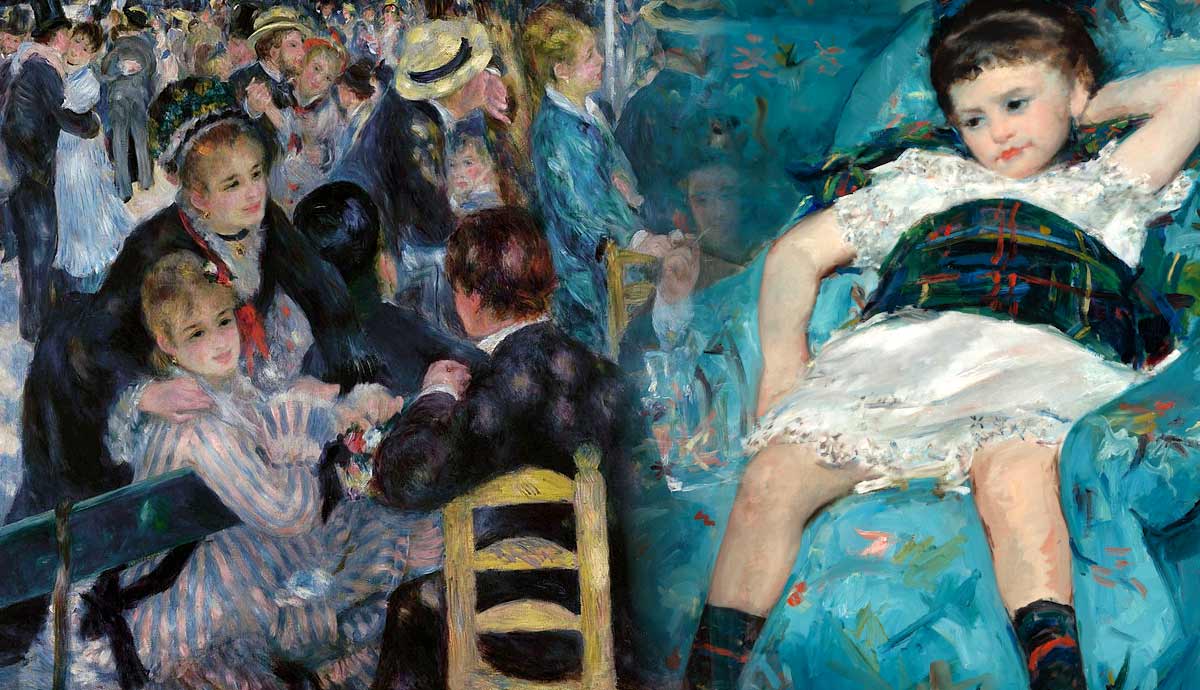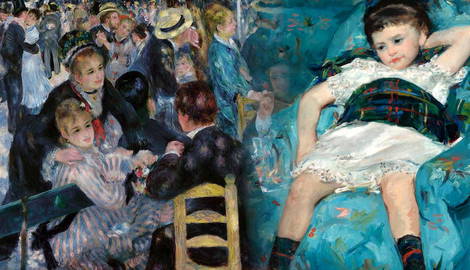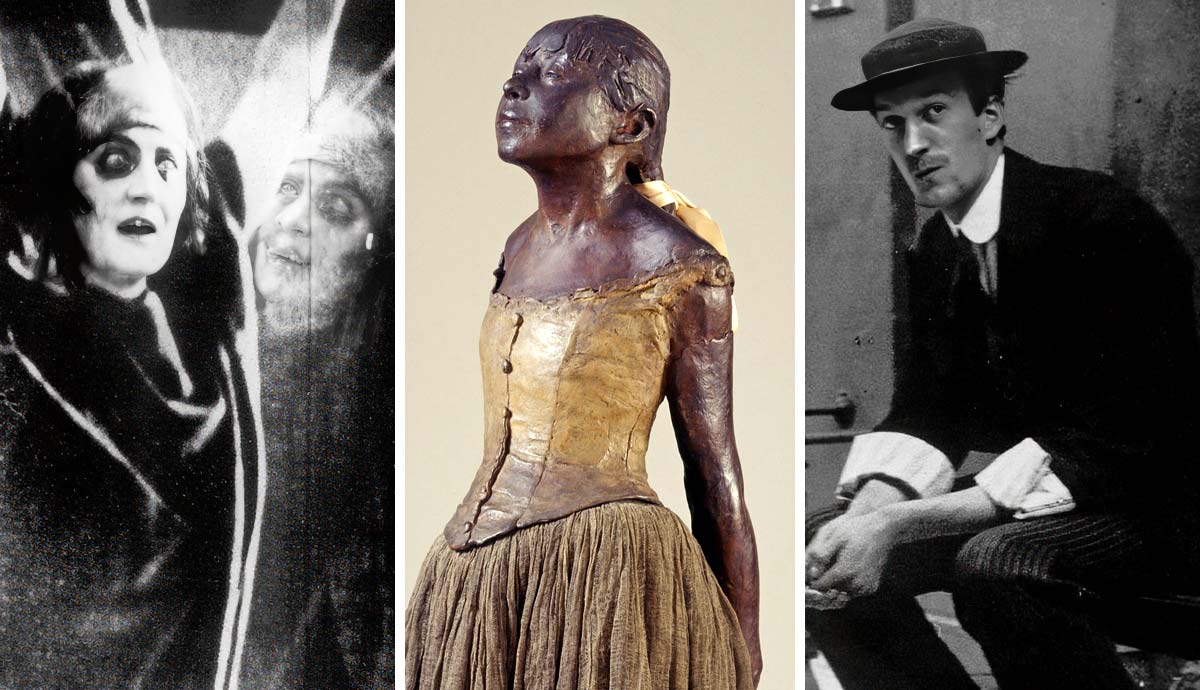
Impressionism started in France with the 1874 exhibition organized by a group of painters who sought to paint landscapes and contemporary life. The techniques, themes, and composition of impressionist paintings took a much clearer shape over the years, leading to multiple exhibitions displaying dozens of artists. Claude Monet is by far the most renowned painter associated with the movement. However, others like Pierre-Auguste Renoir and Berthe Morisot contributed significantly to the 19th-century collection of artworks.
1. The Most Famous Impressionist Painting: Impression, Sunrise

Claude Monet’s Impression, Sunrise is a masterpiece that paved the way for the development of the Impressionist art movement. The painting was displayed in 1874 at the First Impressionist Exhibition. It depicts the port of Le Havre, Monet’s hometown, and is part of a series presenting the port at different times of the day. This particular painting is a depiction of the port at sunrise.
Impression, Sunrise shows two small rowboats on a background of clipper ships. A few more fishing boats can be spotted in the middle ground. Of equal importance as the rowboats is the red sun that leaves its mark on the water. One can easily notice that the painting is proof of how Impressionists distanced themselves from the accurate, photograph-like portrayal of real settings. Although the details are depicted quite vaguely, they are arranged in layers that ensure depth and tangibility.
At first, Impression, Sunrise and other paintings shocked the audience. Some critics claimed they looked unfinished and were unworthy of praise. One critic, inspired by the title of Impression, Sunrise, used the term Impressionism in regard to the paintings displayed at the exhibition. Therefore, Monet’s artwork set in stone the impressionist concept of portraying sensations rather than landscapes. Impression, Sunrise is currently on display at Musée Marmottan Monet in Paris.
2. Dance at Le Moulin de la Galette

Dance at Le moulin de la Galette is an 1876 painting signed by Pierre-Auguste Renoir. It is among the painter’s most renowned works, as it encompasses the elements of his artistic signature like vivid colors, gauzy brushwork, and playful light. The painting was displayed at the 1877 Impressionist Exhibition.
This oil painting shows the Sunday afternoon dance party at Moulin de la Galette of Montmartre. Renoir executed it en plein air and even rushed to finish it as the day was quite windy. The artist had even set up a studio in an abandoned cottage near the mill to execute this artwork and a few others, including The Swing. The painting is filled with light and shadows, which give the whole setting a rainbow-ish aspect. Even the black suits and dresses are interspersed with other shades. The fluidity of the brightly colored brush strokes makes the figures blend in with their surroundings yet not lose themselves in it. Bal du moulin de la Galette is now exhibited at Musée d’Orsay in Paris. In 1976, it served as inspiration for Rod Stewart’s cover for his seventh album, A Night on the Town.
3. The Cradle

Berthe Morisot was one of the few women artists associated with Impressionism. The Cradle encompasses the artist’s elegant and light style and her use of color to create space and depth. It was executed in 1872 and shown at the First Impressionist Exhibition in 1874.
The Cradle portrays Morisot’s sister Edma watching her daughter sleep. It is among the first paintings that outlined Morisot’s preference for depicting motherhood in artworks. The painting composition centers upon diagonality—the mother’s gaze, the crib fabric, and the connection between the mother’s and the baby’s bent arms. All these details draw the viewers into a familiar, protective, and intimate atmosphere.
By focusing on such an intimate setting, Morisot brought to light the beauty of motherhood through means of impressionist techniques. The audience wasn’t too impressed at the time. Firstly, because the author was a woman, and women weren’t supposed to be artists. They were expected to operate in the domestic sphere. Secondly, she portrayed an extremely personal moment that wasn’t typically shown.
As a consequence, she was not successful in selling the painting. Ultimately, Morisot removed it from display, and the work remained in the family collection. In 1930 it was acquired by the Louvre and subsequently moved to Musée d’Orsay in Paris.
4. The Pink Dress

Frédéric Bazille, a close friend of Claude Monet, died before the First Impressionist Exhibition. Despite this, his works are still associated with the movement and were exhibited posthumously by the members of the Anonymous Society of Painters, Sculptors and Engravers, subsequently known as Impressionists. The Pink Dress is among Bazille’s most notable works. He was only 23 years old when he finished it. The artwork stands until today as an iconic Impressionist piece, particularly due to its use of the en plein air technique. Like other members associated with the movement, Bazille was particularly fond of recreating natural light on canvas, a passion we can notice in The Pink Dress. However, since he died before the Impressionist group formed and the concept took a more definite form, his artwork also featured some realist characteristics. For example, the middle ground is filled with trees, an element inspired by the Barbizon School, and aims at highlighting the difference between the foreground and the background.
5. Boulevard des Capucines

Boulevard des Capucines is yet another artwork signed by Claude Monet. It depicts the Parisian boulevard in bright colors outlining the playful nature of light. Although it portrays a real place, it lacks the realistic, clear-cut depiction seen in prior art movements. Instead, it is Monet’s personal perception of the landscape. One can clearly notice how the fluidity of the short, quick brush strokes stunningly captures the elusiveness of the movement.
This artwork also shows the way Japanese art influenced Impressionists. More precisely, we notice how Monet relied on the linear perspective of ukiyo-e to create depth. This illusion of depth is produced by the buildings on the left and the trees in the middle.
Claude Monet executed two artworks with the same name. Both were made in an apartment belonging to his friend and photographer Nadar. In 1874, one of the two was displayed at the Impressionist Exhibition. One of the paintings is now at the Pushkin Museum in Moscow, while the other is housed in Kansas City at the Nelson-Atkins Museum of Art.
6. A Modern Olympia

Paul Cézanne is most often associated with Post-Impressionism rather than Impressionism. However, until the artist outlined a more precise direction of his art, he executed a series of artworks in the impressionist style, which were even displayed at their exhibitions. An example is A Modern Olympia executed between 1873 and 1874. It was inspired by Edouard Manet’s Olympia.
This painting was made using bright colors and noticeable contrasts, showing a clear impressionist tendency. Like other artworks associated with the movement, A Modern Olympia looks more like a sketch than a finished artwork due to its brush strokes. Some critics even claimed that A Modern Olympia was created by a madman in a delirious state of mind.
Today, Paul Cézanne is known for his accuracy, perfectionism, and emphasis on geometric compositions. This, however, does not make him a less important figure in the Impressionist movement. A Modern Olympia was one of the artworks that aroused the audience’s attention and caused a contemptuous critical reaction after its display at the 1874 Impressionist Exhibition. The work is currently on display at the Musée d’Orsay in Paris.
7. Little Girl in a Blue Armchair

Little Girl in a Blue Armchair is a painting signed by the Impressionist Mary Cassatt. It depicts, just as its title says, a girl sitting in a blue armchair, accompanied by a sleeping dog. One can easily observe how, like other Impressionists, Mary Cassatt made use of vibrant, highly contrasting colors applied in separate strokes on the canvas. This way, she invited the viewers to merge the colors themselves, thus creating their own impression of the image. She also played with the lights coming through the doors.
Edgar Degas’ influence on Cassatt’s artwork is clearly visible in Little Girl in a Blue Armchair; he is even thought to have contributed with some retouches to the final painting. Edgar Degas is also considered an Impressionist, although he associated himself with realism. We notice his influence on Cassatt’s artwork in its asymmetrical composition, as well as the cropping of the image inspired by the Japanese ukiyo-e. Little Girl in a Blue Armchair is currently on display at the Philadelphia Museum of Art until 8 September 2024, and then it will travel to the Legion of Honor, San Francisco.
8. A Classy Impressionist Painting: The Blue Lady

La Parisienne, or The Blue Lady, was one of the seven Renoir artworks displayed at the First Impressionist Exhibition. It was completed in 1874 and, like others on display, did not receive too many positive reviews. The painting depicts a woman wearing a fashionable long blue dress. Her head and eyes are turned toward the viewers as if she were taking a moment to observe us while putting on her gloves.
The background is a mix of blue, whitish, and yellow, contrasting heavily with the woman’s dress, which, in turn, contrasts with her face. While the woman’s appearance is executed in more detail, the background is quite blurry and shows more loose brush strokes. This makes the lady appear as if she were floating, lost in the composition. We do not know if it’s a portrait, we do not know who the woman is, and we do not know where she is—in short, Renoir shows us a painting with no context.
It was later revealed that the model for the painting had been Henriette Henriot, a 16-year-old actress. She was Renoir’s favorite model and appeared in at least a dozen other artworks signed by him. La Parisienne is currently on display at the National Museum Cardiff in Cardiff, Wales.










